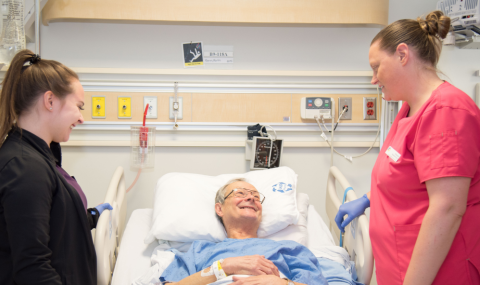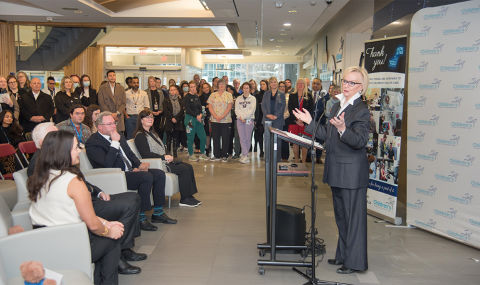MEDIA RELEASE
For Immediate Release
May 7 , 2015
(LONDON, Ontario) – Renovations will soon commence at both of the city's Emergency Departments (EDs), signaling the start of sweeping changes planned to improve clinical service delivery at London Health Sciences Centre (LHSC) over the coming year.
"After comprehensive work over the past two years to map a new course and redesign key care processes, LHSC will soon begin to introduce a series of changes in practice and process across the hospital, including a new model of care in the EDs," says Murray Glendining, President and CEO, LHSC. "Our goal is to significantly improve several key hospital performance metrics, such as reduced time to see an ED physician, reduced wait times when hospital admission is required, and reduced length of stay in hospital as a result of improved processes."
Before implementation can begin, renovations are needed to modify layouts to support the new ED model of care [for more information about the new ED model of care, see attached media backgrounder]. This work will begin at Victoria Hospital on May 26 and at University Hospital on June 16, with each project lasting approximately six weeks. This timing compresses the work as much as possible and takes advantage of the typically lower patient volumes in the summer months. Both EDs will remain open through renovations, and while patients may be inconvenienced, they can be assured that contingencies will be in place to manage patient volumes during this period in as timely a manner as possible.
"The changes planned across all clinical services will ensure that patients are better served and the staff and physician experience is improved, through a high quality, safe, integrated, streamlined and sustainable care system," says Dr. Mark MacLeod, Chief Medical Officer at LHSC. "As an outcome of this work, the hospital has targeted an average occupancy level of 95% while maintaining or improving quality and safety, to ensure that we create a system that provides the right care, the right way, every time."
Once the renovations are complete, modeling of the new ED model of care will resume within the new, purpose-designed ED layout and refinement will continue, with phased implementation planned for fall 2015.
"A key component of this work has been engagement of many of our front line staff and physicians, as well as patients and families and community and health system partners," adds Glendining. "Their active support has been pivotal in helping develop the most effective solutions for a better system of care. There is much to do and we will take a measured approach, but we are excited about our new direction, which we believe will result in a far better experience for the patients we serve once fully implemented."
About London Health Sciences Centre
London Health Sciences Centre has been at the forefront of medicine in Canada for 140 years and offers the broadest range of specialized clinical services in Ontario. Building on the traditions of its founding hospitals to provide compassionate care in an academic teaching setting, London Health Sciences Centre is home to Children's Hospital, University Hospital, Victoria Hospital, the Kidney Care Centre, two family medical centres, and two research institutes - Children's Health Research Institute and Lawson Health Research Institute. As a leader in medical discovery and health research, London Health Sciences Centre has a history of over 65 international and national firsts and attracts top clinicians and researchers from around the world. As a regional referral centre, London Health Sciences Centre cares for the most medically complex patients including critically injured adults and children in southwestern Ontario and beyond. The hospital's nearly 15,000 staff, physicians, students and volunteers provide care for more than one million patient visits a year. For more information visit www.lhsc.on.ca.
- 30 -
Note to Media:
Murray Glendining, President and CEO, is available for media interviews today, Thursday, May 7, 3:00 - 4:30 p.m.
For media inquiries contact:
Mandy Gelinas
Corporate Communications and Public Relations
London Health Sciences Centre
519-685-8500, ext. 75157
mandy.gelinas@lhsc.on.ca
After-hours and weekend assistance:
Call LHSC Switchboard at 519-685-8500 and ask to page the communication consultant on-call.
BACKGROUNDER - New ED Care Model
For the past 18 months, project teams consisting largely of front line staff and physicians have been using Toyota Production System methodologies to redesign the way clinical services are delivered. This work started in the Emergency Departments (EDs) and expanded to include the Mental Health Care program and admission and discharge areas of Medicine. In parallel, every clinical service area has been working on initiatives that will improve patient access and flow by improving internal processes, including developing a pull system from the ED to expedite movement of patients to the most appropriate care setting.
In many cases, the teams have not simply looked to make improvements to existing practices, but rather considered entirely new ways to deliver care. For the EDs, this meant designing a completely new model. Ongoing simulation and refinement has validated the significant potential of this new model of care and the Mental Health and Medicine teams are also in various stages of modeling and executing new practices to support the EDs, including working as an integrated part of the ED care teams.
Under the new model, time to see a physician is significantly reduced and many patients will have a much shorter stay in the ED than is the case today. Patients arriving in the EDs will be served in three distinct geographic areas called Care Bubbles (Front, Middle and Back), with each Care Bubble designated to care for certain cohorts of patients based upon their needs and acuity. Each Care Bubble will be staffed with multidisciplinary teams consisting of physicians, nurses, clerical support and emergency department technicians. Staff and physicians from other services like Mental Health and Medicine will also be integrated in the ED Care Bubble model to streamline the process and better manage transitions from the EDs, whether to ambulatory clinics or inpatient units at LHSC, or to other care providers, support services, or home.
The new model is based on a 'first in, first seen' philosophy, which is a real departure from the current ED triage process which prioritizes medical access based upon severity of condition. The new process still ensures immediate access to care for high acuity (most severely ill or injured) patients. As well, the ED Resuscitation Response Team will continue to be assembled as trauma patients are en route, and that team will provide care for the patient in the Resuscitation/Trauma room as we do today. However, caring for these highest acuity patients will no longer delay provision of care to other patients to the ED.
After being quickly registered, all patients will be seen in the Front Care Bubble within minutes for initial assessment and treatment. Depending on the outcome of the initial assessment, some patients will be treated and discharged directly from this Front Care Bubble, while others will be directed to the Middle or Back Care Bubbles.
Patients that are transferred to the Middle Care Bubble are those who - after further medical care, a procedure, or a consult - will likely be discharged within three hours. Once again, this represents a substantial reduction in visit duration for this cohort of patients. Patients in the Middle Care Bubble who do not progress as expected, or have changing medical needs, will be advanced to the Back Care Bubble.
Patients directed to the Back Care Bubble are either definite candidates for admission, or are those who could still potentially be discharged, but will need more than three hours of observation or treatment by either the ED physician and staff team, or a non-ED clinical service like Medicine, Surgery or Mental Health. The Back Care Bubble ensures immediate access to medical care for higher acuity patients and more timely and appropriate discharge from the ED, to the next most appropriate level of care. For those needing hospital admissions, a number of other new approaches to delivering care are being developed across LHSC to expedite hospital access, improve patient services, and streamline transitions from hospital when acute care is no longer required.
Under the new model, time to see a physician is significantly reduced and many patients will have a much shorter stay in the ED than is the case today. Feedback from modeling sessions has been consistently positive: the patient experience is significantly enhanced with quick access to a physician, shorter wait and disposition times, reduced wait time to admission when required, and a much more streamlined process that eliminates many of the repetitive and non-value-added steps experienced in the current approach. The process is also much improved from a quality of care and care provider perspective.
Visit the LHSC Media Room website at www.lhsc.on.ca/media.
Like us on Facebook at London Health Sciences Centre (LHSC), follow us on Twitter @LHSCCanada and watch us on YouTube at LHSCCanada.


